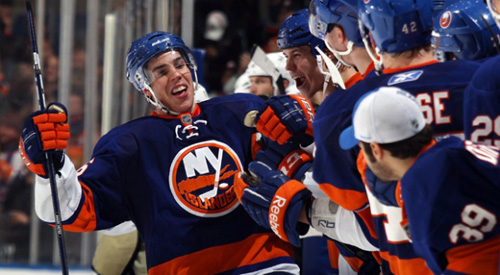
Projecting the NHL’s breakout stars in 2011-12
With apologies to fans of the Edmonton Oilers, Colorado Avalanche, Florida Panthers and New Jersey Devils, it is highly unlikely the lottery picks from the 2011 NHL Entry Draft will immediately step into the league and breakout as stars in 2011-12.
Instead, when examining players poised for coming out parties, one thing stands out: breakout players have faced some adversity. Whether it was playing in an advanced role as an injury fill-in, getting rushed to the big league too soon or taking a few seasons to catch up to the speed of the NHL, there are a myriad of factors that stall the development of talented hockey prospects.
Case in point, when Mark Streit went down with a shoulder injury and missed the entire 2010-11 season, the biggest benefactor was rookie defenseman Travis Hamonic, the Islanders’ second-round pick in 2008.
As a 20-year-old, Hamonic was thrust into the shutdown role for New York and played with poise beyond his years. He had the strongest quality of competition rate on Long Island – a measure of the plus-minus of opposing players weighed by head-to-head ice time. His relative corsi statistic of 7.5 – a metric that measures on-ice shot differential and reflects puck possession – was tops amongst New York rearguards.
Hamonic, known as an all-around defenseman rather than an offensive force, also tallied five goals and 26 points in 62 games and was one of only six Islanders to finish with a plus rating.
The 6’2″, 208-pound blueliner is a tough customer who protects his teammates, as he amassed a team-high 103 penalty minutes while throwing 118 hits, fourth most for New York last year.
[php snippet=1]
In 2010-11, the Winnipeg, Manitoba native proved he can eat up minutes with the best of them. With a healthy Islanders defense corps, however, Hamonic could be used in more favorable situations and produce at a higher level in his sophomore season.
The fact that Hamonic honed his game for four seasons in the WHL and was not rushed to the big club is certainly a chief factor in the defenseman’s ascension.
At the professional level, not all prospects are treated equally and, in retrospect, it is clear that Phoenix Coyotes center Kyle Turris was not given sufficient time to develop before becoming an NHL regular.
Turris was drafted out of the BCHL and spent just one season with the Wisconsin Badgers prior to his promotion to the Desert Dogs. Despite being physically underdeveloped, the Coyotes called-up the New Westminster, B.C. native as an 18-year-old for the last three games of the 2007-08 season.
Unsurprisingly, Turris spent the next three seasons splitting time with the Coyotes and AHL-affiliate San Antonio.
Last season, Turris established new benchmarks in games played, goals, assists and points. The Coyotes, who have an unfair reputation as an offensively-inept franchise, employ a scoring-by-committee system. Said strategy resulted in 226 goals in 2010-11, 14th most in the league.
Turris’ underlying statistics reveal he was unlucky to not score more often last season, as he had the best corsi and relative corsi rate out of all Coyotes players. Moreover, he led Phoenix with a 1.05 goals per 60 minutes metric – indicating he scored goals at 5-on-5 at a greater rate than all of his teammates.
This coming campaign, expect Turris to surpass the 50-point plateau in what will be a standout 2011-12 season for the emerging down-the-middle talent.
Back in the Eastern Conference, Philadelphia Flyers hulking left winger James van Riemsdyk, who was drafted one spot ahead of Turris, projects to truly break through come September.
The Old Bridge, New Jersey-born forward played for the US national team development program as well as NCAA hockey for the University of New Hampshire before donning Philly’s orange and black.
JVR has tantalized Flyers fans for a pair of seasons thus far, with his rare combination of size and athleticism. On the other hand, he has struggled to find consistency at the NHL level.
Claude Giroux truly emerged as an NHL star in the 2009-10 postseason, and van Riemsdyk followed the model of his teammate a season later. Like his teammate, JVR used the 2010-11 playoffs as his coming out party. He was a dominant force for Philadelphia scoring seven goals in just 11 games during the Flyers disappointing playoff run.
With Mike Richards and Jeff Carter unceremoniously exiled from Broad Street, van Riemsdyk and Giroux are now the cornerstones of the franchise. JVR’s offensive opportunities will only increase and the winger looks poised for a 30-goal season in Philadelphia.
[php snippet=1]

